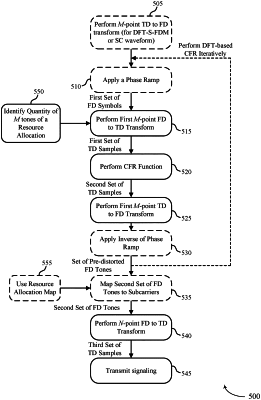| CPC H04L 27/2614 (2013.01) [H04W 72/044 (2013.01)] | 26 Claims |

|
1. A method for wireless communication at a device, comprising:
applying a first phase ramp to a first set of frequency-domain tones to obtain a phase-ramped set of frequency-domain tones;
performing, subsequent to applying the first phase ramp to the first set of frequency-domain tones, a first frequency-domain to time-domain transform on the first set of frequency-domain tones to obtain a first set of time-domain samples, wherein the first frequency-domain to time-domain transform has a first transform size, wherein the first phase ramp corresponds to a first time-domain shift for the first set of time-domain samples, and wherein performing the first frequency-domain to time-domain transform comprises performing the first frequency-domain to time-domain transform on the phase-ramped set of frequency-domain tones;
performing a crest factor reduction function on the first set of time-domain samples to obtain a second set of time-domain samples;
performing a first time-domain to frequency-domain transform on the second set of time-domain samples to obtain a pre-distorted set of frequency-domain tones;
applying an inverse of the first phase ramp to the pre-distorted set of frequency-domain tones to remove the first time-domain shift and to obtain a first pre-distorted set of frequency-domain tones;
mapping the pre-distorted set of frequency-domain tones to at least a portion of a second set of frequency-domain tones, wherein the second set of frequency-domain tones is larger than the first set of frequency-domain tones;
performing a second frequency-domain to time-domain transform on the second set of frequency-domain tones to obtain a third set of time-domain samples, wherein the second frequency-domain to time-domain transform has a second transform size that is larger than the first transform size; and
transmitting signaling based at least in part on the third set of time-domain samples, wherein transmitting the signaling is based at least in part on applying the inverse of the first phase ramp to the pre-distorted set of frequency-domain tones to remove the first time-domain shift.
|